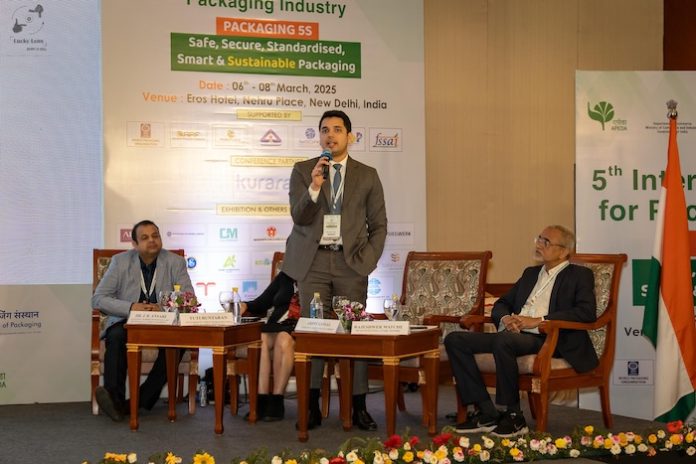
On the second day of the 5th International Summit for the Packaging Industry in Delhi, Arpit Goyal, managing director of the GLS Group India emphasized the crucial role of sustainability and innovation in shaping the future of the packaging industry. Sharing his thoughts on a sustainable future, he highlighted the company’s proactive steps to drive eco-friendly advancements using renewable, recyclable, and eco-friendly materials and innovative solutions for sustainable packaging.
GLS Group’s sustainable initiatives in each of 5 verticals
Goyal described the group’s five key verticals — GLS Films for flexible packaging, GLS Polyfilms for packaging and industrial applications, GLS Elopak for aseptic solutions, GLS Aluminium for developing sustainable aluminum foils, and GLS Chemicals for innovating with environmentally friendly inks and coatings aligned to global sustainability norms.
GLS Film’s development of a PET-PET structure involves laminating 10-micron polyester to 23-micron polyester, or a 12-micron polyester to a 19-micron polyester. “This forms a single polymer family plastic structure which is 100% recyclable, and offers excellent Water Vapor Transmission Rate (WVPR) and Oxygen Transmission Rate (OTR) properties, and high seal strength,” Goyal noted. Additionally, GLS Films has developed another easily recyclable solution – PE-PE laminates. “Every day we are reducing and down-sizing our structures and making our substrates thinner,” he said, noting that GLS Films now can print on 6-micron BOPET films and 10-micron BOPP films, for minimizing material.
Equipped with a 10.6-meter-wide ABC polyester line from Dornier, GLS Polyfilms can produce even 6-micron polyester films with a monthly production capacity of 4,000 tons. An innovation from this division is using PCR inputs to produce a film with up to 90% recyclability.
GLS Aluminium has produced foils almost as thin as one micron, retaining properties comparable to conventional 6.35 or 7-micron aluminum foils. Goyal emphasized that thinner foil results in more mileage, lower environmental impact, and reduced material consumption. Speaking about GLS Chemicals, he said this company has recently commercialized water-based inks that can print on polyester, BOPP, or paper substrates.
According to him, the aseptic packaging industry is growing at a double-digit CAGR and to an extent has replaced traditional packaging in PET and glass bottles. He credited the growth to tamper-proof design, adulteration resistance, and extended shelf life. “GLS Elopak has lowered the cost by 20 to 30% by optimizing the pack structure. We have made a 6-layer laminate structure using FDA-approved paperboard, recyclable polymers, better quality aluminum foil, and other sustainable materials,” said Goyal. He noted that the recycling infrastructure for this particular industry is maturing. “Now we can successfully collect and recycle aseptic beverage packs.”
Looking ahead, GLS Elopak is set to launch its PurePak range of products — a naturally sustainable and consumer-friendly alternative to plastic bottles. PurePak offers numerous environmental benefits, including reduced plastic usage, full recyclability, and the use of renewable materials. Goyal expressed confidence that PurePak will not only replace plastic bottles but also traditional packaging formats such as glass bottles and loose pasteurized milk packaging.
Innovation and sustainability
Since he joined the GLS Group in 2019, Goyal said that he has witnessed a shift in the packaging space, where sustainability has emerged as a central focus. “Sustainability is anything that minimizes the environmental impact,” he remarked, emphasizing the need for packaging to retain its primary function of protecting the product while reducing its carbon footprint.
Achieving sustainability involves using materials that are both environmentally friendly and functionally effective, he said, insisting that the packaging must maintain the quality and safety of food and other products while leaving minimal impact on the planet. “The basic principle of packaging is to keep the functional properties intact, ensuring product safety.”
Despite the growing demand for sustainable packaging, Goyal acknowledged that a variety of challenges obstruct its mass adoption. He named three primary factors that often deter brands and consumers from choosing eco-friendly packaging – Seal Strength and Oxygen Transmission Rate (OTR), aesthetic appeal, and the cost factor.
Food safety and hygiene are paramount
According to him, ensuring sustainable materials maintain the necessary seal strength and barrier properties for product preservation is still a technical challenge. Considering the costs, he pointed out that sustainable packaging often comes at a premium, and convincing brands and consumers to bear this additional cost can be difficult.
“Overcoming these challenges brings us to the new challenge of mass production. Producing one or two samples as a pilot project is different, but when you have to produce 100-200 tons at the commercial stage, there are supply chain, value chain, and many more challenges,” he explained.
Goyal believes that the transition to sustainability is a shared responsibility. From producers to consumers and regulatory bodies, every stakeholder in the sustainability chain has a role to play. He pointed out that the recycling infrastructure in India is still underdeveloped, posing a hurdle in ensuring responsible waste management.
“In a country like India, the recycling infrastructure is not mature enough to handle the burden, but we are moving forward without any restrictions,” Goyal noted. He emphasized the importance of creating an integrated ecosystem where each entity actively participates in sustainability efforts.
“In terms of cost, sustainability is about balancing the needs of all stakeholders,” he emphasized while urging government bodies and institutions such as the IIP to link all these together to create an efficient sustainability chain.









